Electromagnetic Nanocoils Based on InGaN Nanorings
Abstract
1. Introduction
2. Materials and Methods
3. Results
4. Conclusions
Supplementary Materials
Author Contributions
Funding
Data Availability Statement
Acknowledgments
Conflicts of Interest
References
- Fafard, S.; Hinzer, K.; Raymond, S.; Dion, M.; McCaffrey, J.; Feng, Y.; Charbonneau, S. Red-Emitting Semiconductor Quantum Dot Lasers. Science 1996, 274, 1350–1353. [Google Scholar] [CrossRef] [PubMed]
- Devoret, M.H.; Schoelkopf, R.J. Amplifying quantum signals with the single-electron transistor. Nature 2000, 406, 1039–1046. [Google Scholar] [CrossRef] [PubMed]
- Chaplik, A.V. Magnetoexcitons in quantum rings and in antidots. JETP Lett. 1995, 62, 900–904. [Google Scholar]
- Aharonov, Y.; Bohm, D. Significance of Electromagnetic Potentials in the Quantum Theory. Phys. Rev. B 1959, 115, 485–491. [Google Scholar] [CrossRef]
- Lorke, A.; Luyken, R.J.; Govorov, A.O.; Kotthaus, J.P.; Garcia, J.M.; Petroff, P.M. Spectroscopy of Nanoscopic Semiconductor Rings. Phys. Rev. Lett. 2000, 84, 2223–2226. [Google Scholar] [CrossRef]
- Warburton, R.J.; Schäflein, C.; Haft, D.; Bickel, F.; Lorke, A.; Karrai, K.; Garcia, J.M.; Schoenfeld, W.; Petroff, P.M. Optical emission from a charge-tunable quantum ring. Nature 2000, 405, 926–929. [Google Scholar] [CrossRef]
- Bayer, M.; Korkusinski, M.; Hawrylak, P.; Gutbrod, T.; Michel, M.; Forchel, A. Optical Detection of the Aharonov-Bohm Effect on a Charged Particle in a Nanoscale Quantum Ring. Phys. Rev. Lett. 2003, 90, 186801. [Google Scholar] [CrossRef]
- Römer, R.A.; Raikh, M.E. Aharonov-Bohm effect for an exciton. Phys. Rev. B 2000, 62, 7045–7049. [Google Scholar] [CrossRef]
- Moulopoulos, K.; Constantinou, M. Two interacting charged particles in an Aharonov-Bohm ring: Bound state transitions, symmetry breaking, persistent currents, and Berry’s phase. Phys. Rev. B 2004, 70, 235327. [Google Scholar] [CrossRef]
- Song, J.; Ulloa, S.E. Magnetic field effects on quantum ring excitons. Phys. Rev. B 2001, 63, 125302. [Google Scholar] [CrossRef]
- Maslov, A.V.; Citrin, D.S. Enhancement of the Aharonov-Bohm effect of neutral excitons in semiconductor nanorings with an electric field. Phys. Rev. B 2003, 67, 121304. [Google Scholar] [CrossRef]
- Hu, H.; Zhu, J.-L.; Li, D.-J.; Xiong, J.-J. Aharonov-Bohm effect of excitons in nanorings. Phys. Rev. B 2001, 63, 195307. [Google Scholar] [CrossRef]
- Govorov, A.O.; Ulloa, S.E.; Karrai, K.; Warburton, R.J. Polarized excitons in nanorings and the optical Aharonov-Bohm effect. Phys. Rev. B 2002, 66, 081309. [Google Scholar] [CrossRef]
- Barticevic, Z.; Fuster, G.; Pacheco, M. Effect of an electric field on the Bohm-Aharonov oscillations in the electronic spectrum of a quantum ring. Phys. Rev. B 2002, 65, 193307. [Google Scholar] [CrossRef]
- Dias da Silva, L.G.G.V.; Ulloa, S.E.; Govorov, A.O. Impurity effects on the Aharonov-Bohm optical signatures of neutral quantum-ring magnetoexcitons. Phys. Rev. B 2004, 70, 155318. [Google Scholar] [CrossRef]
- Eaglesham, D.J.; Cerullo, M. Dislocation-free Stranski-Krastanow growth of Ge on Si(100). Phys. Rev. Lett. 1990, 64, 1943–1946. [Google Scholar] [CrossRef]
- García, J.M.; Medeiros-Ribeiro, G.; Schmidt, K.; Ngo, T.; Feng, J.L.; Lorke, A.; Kotthaus, J.; Petroff, P.M. Intermixing and shape changes during the formation of InAs self-assembled quantum dots. Appl. Phys. Lett. 1997, 71, 2014–2016. [Google Scholar] [CrossRef]
- García, J.M.; Silveira, J.P.; Briones, F. Strain relaxation and segregation effects during self-assembled InAs quantum dots formation on GaAs(001). Appl. Phys. Lett. 2000, 77, 409–411. [Google Scholar] [CrossRef]
- Warburton, R.J.; Schäflein, C.; Haft, D.; Bickel, F.; Lorke, A.; Karrai, K.; Garcia, J.M.; Schoenfeld, W.; Petroff, P.M. Optical emission from single, charge-tunable quantum rings. Phys. E 2001, 9, 124–130. [Google Scholar] [CrossRef]
- Luyken, A.L.J.; Garcia, J.M.; Petroff, P.M. Growth and Electronic Properties of Self-Organized Quantum Rings. Jpn. J. Appl. Phys. 2001, 40, 1857. [Google Scholar] [CrossRef]
- Blossey, R.; Lorke, A. Wetting droplet instability and quantum ring formation. Phys. Rev. E 2002, 65, 021603. [Google Scholar] [CrossRef] [PubMed]
- Granados, D.; García, J.M. In(Ga)As self-assembled quantum ring formation by molecular beam epitaxy. Appl. Phys. Lett. 2003, 82, 2401–2403. [Google Scholar] [CrossRef]
- Raz, T.; Ritter, D.; Bahir, G. Formation of InAs self-assembled quantum rings on InP. Appl. Phys. Lett. 2003, 82, 1706–1708. [Google Scholar] [CrossRef]
- Kong, X.Y.; Ding, Y.; Yang, R.; Wang, Z.L. Single-Crystal Nanorings Formed by Epitaxial Self-Coiling of Polar Nanobelts. Science 2004, 303, 1348–1351. [Google Scholar] [CrossRef]
- Yin, Y.; Rioux, R.M.; Erdonmez, C.K.; Hughes, S.; Somorjai, G.A.; Alivisatos, A.P. Formation of Hollow Nanocrystals Through the Nanoscale Kirkendall Effect. Science 2004, 304, 711–714. [Google Scholar] [CrossRef]
- Mano, T.; Nötzel, R.; Hamhuis, G.J.; Eijkemans, T.J.; Wolter, J.H. Formation of InAs quantum dot arrays on GaAs (100) by self-organized anisotropic strain engineering of a (In,Ga)As superlattice template. Appl. Phys. Lett. 2002, 81, 1705–1707. [Google Scholar] [CrossRef]
- Brune, H.; Giovannini, M.; Bromann, K.; Kern, K. Self-organized growth of nanostructure arrays on strain-relief patterns. Nature 1998, 394, 451–453. [Google Scholar] [CrossRef]
- Facsko, S.; Dekorsy, T.; Koerdt, C.; Trappe, C.; Kurz, H.; Vogt, A.; Hartnagel, H.L. Formation of Ordered Nanoscale Semiconductor Dots by Ion Sputtering. Science 1999, 285, 1551–1553. [Google Scholar] [CrossRef]
- Schmidt, O.G.; Jin-Phillipp, N.Y.; Lange, C.; Denker, U.; Eberl, K.; Schreiner, R.; Gräbeldinger, H.; Schweizer, H. Long-range ordered lines of self-assembled Ge islands on a flat Si (001) surface. Appl. Phys. Lett. 2000, 77, 4139–4141. [Google Scholar] [CrossRef]
- Kiravittaya, S.; Heidemeyer, H.; Schmidt, O.G. Growth of three-dimensional quantum dot crystals on patterned GaAs (001) substrates. Phys. E 2004, 23, 253–259. [Google Scholar] [CrossRef]
- Kiravittaya, S.; Schmidt, O.G. Comment on “A growth pathway for highly ordered quantum dot arrays” [Appl. Phys. Lett. 85, 5974 (2004)]. Appl. Phys. Lett. 2005, 86, 206101. [Google Scholar] [CrossRef]
- Kim, S.-W.; Ueda, M.; Funato, M.; Fujita, S.; Fujita, S. Artificial control of ZnO nanodots by ion-beam nanopatterning. J. Appl. Phys. 2005, 97, 104316. [Google Scholar] [CrossRef]
- Ishikawa, T.; Kohmoto, S.; Nishimura, T.; Asakawa, K. In situ electron-beam processing for III–V semiconductor nanostructure fabrication. Thin Solid Films 2000, 373, 170–175. [Google Scholar] [CrossRef]
- Chen, P.; Chua, S.J.; Wang, Y.D.; Sander, M.D.; Fonstad, C.G. InGaN nanorings and nanodots by selective area epitaxy. Appl. Phys. Lett. 2005, 87, 143111. [Google Scholar] [CrossRef]
- Chen, A.; Chua, S.J.; Chen, P.; Chen, X.Y.; Jian, L.K. Fabrication of sub-100 nm patterns in SiO2 templates by electron-beam lithography for the growth of periodic III–V semiconductor nanostructures. Nanotechnology 2006, 17, 3903–3908. [Google Scholar] [CrossRef]
- Chen, P.; Chen, A.; Chua, S.J.; Tan, J.N. Growth and Optical Properties of Highly Uniform and Periodic InGaN Nanostructures. Adv. Mater. 2007, 19, 1707–1710. [Google Scholar] [CrossRef]
- Pantha, B.N.; Wang, H.; Khan, N.; Lin, J.Y.; Jiang, H.X. Origin of background electron concentration in In x Ga 1− x N alloys. Phys. Rev. B 2001, 84, 075327. [Google Scholar] [CrossRef]
- Liu, W.; Zhao, D.; Jiang, D.; Chen, P.; Shi, D.; Liu, Z.; Zhu, J.; Yang, J.; Li, X.; Liang, F.; et al. Influence of Indium Content on the Unintentional Background Doping and Device Performance of InGaN/GaN Multiple-Quantum-Well Solar Cells. IEEE J. Photovolt. 2017, 7, 1017–1023. [Google Scholar] [CrossRef]
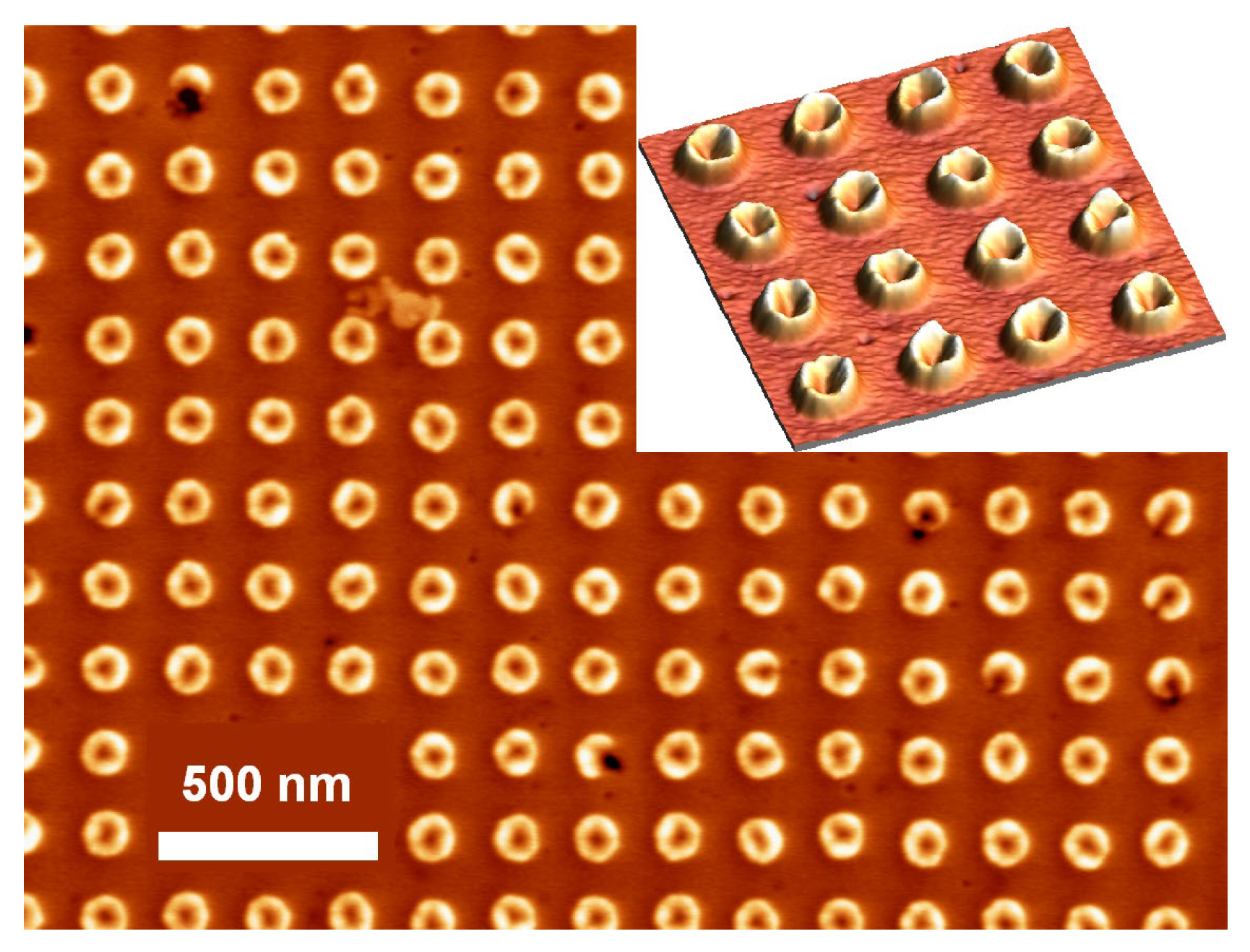
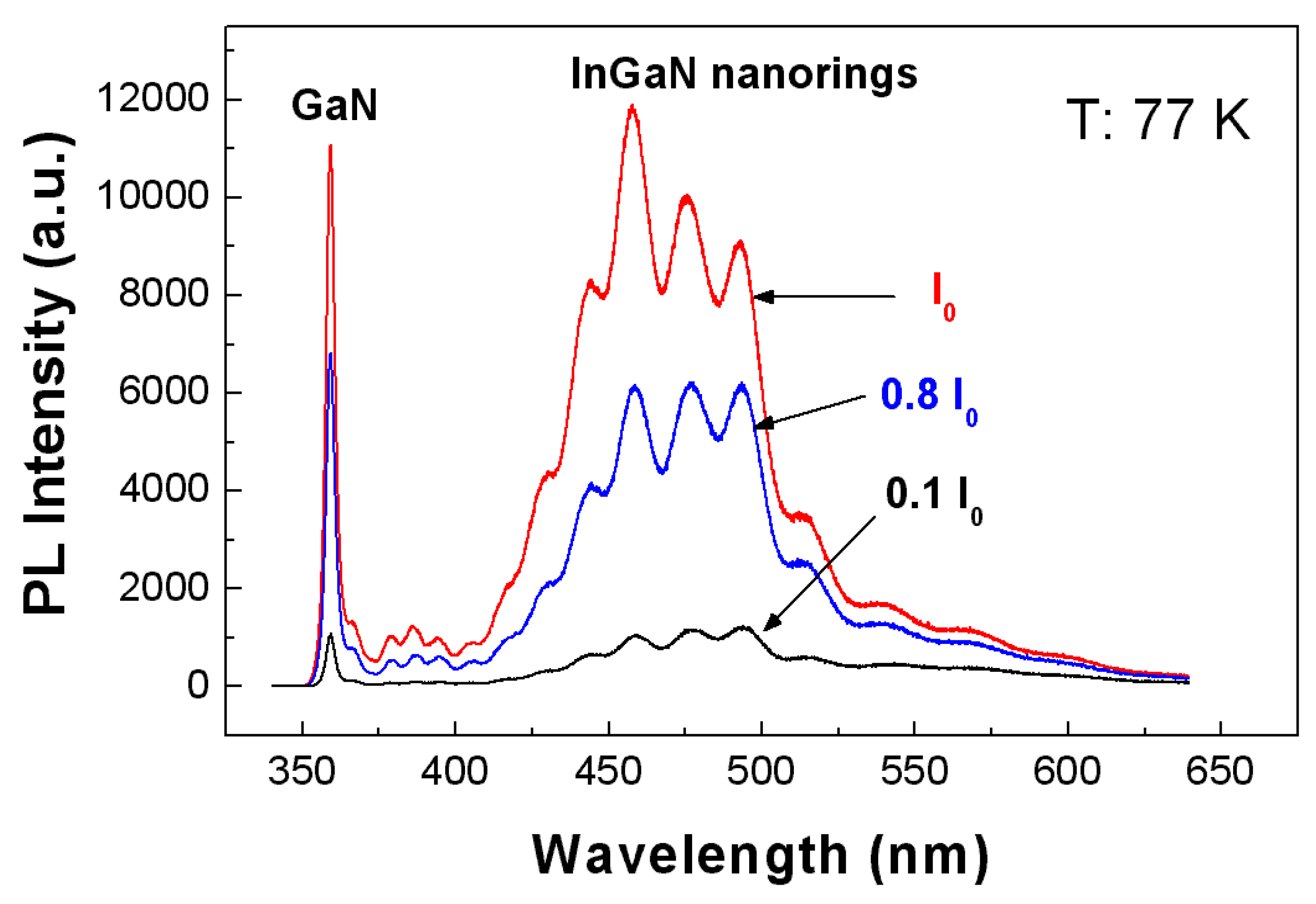
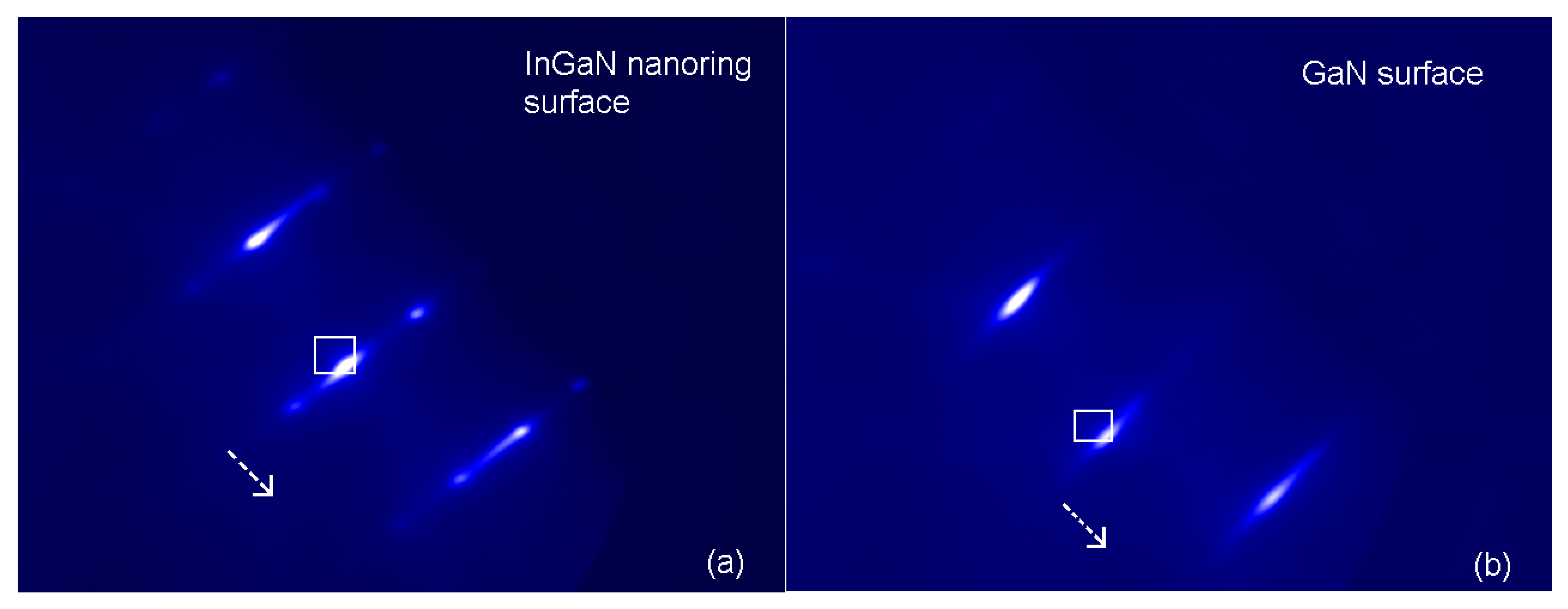
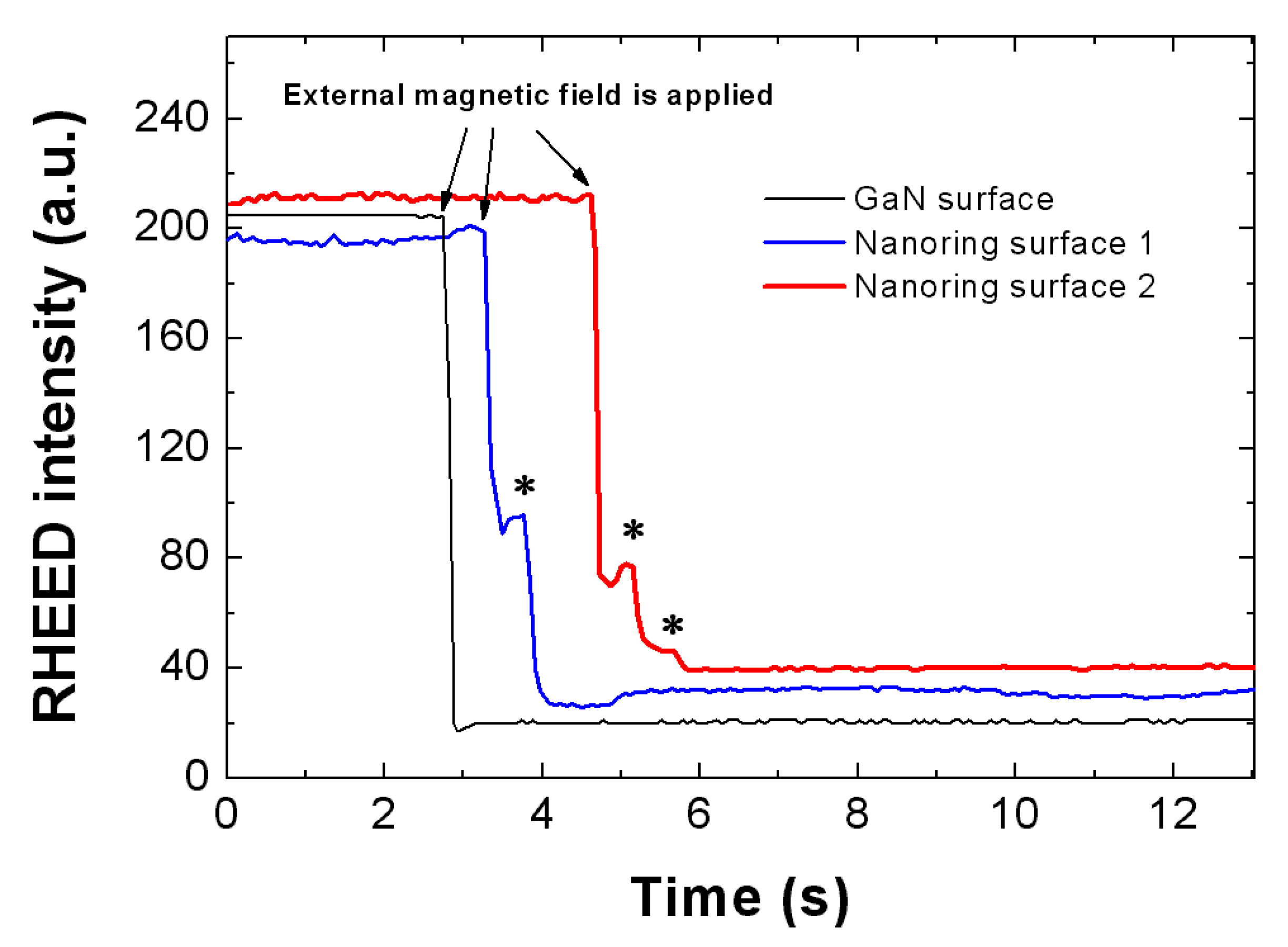
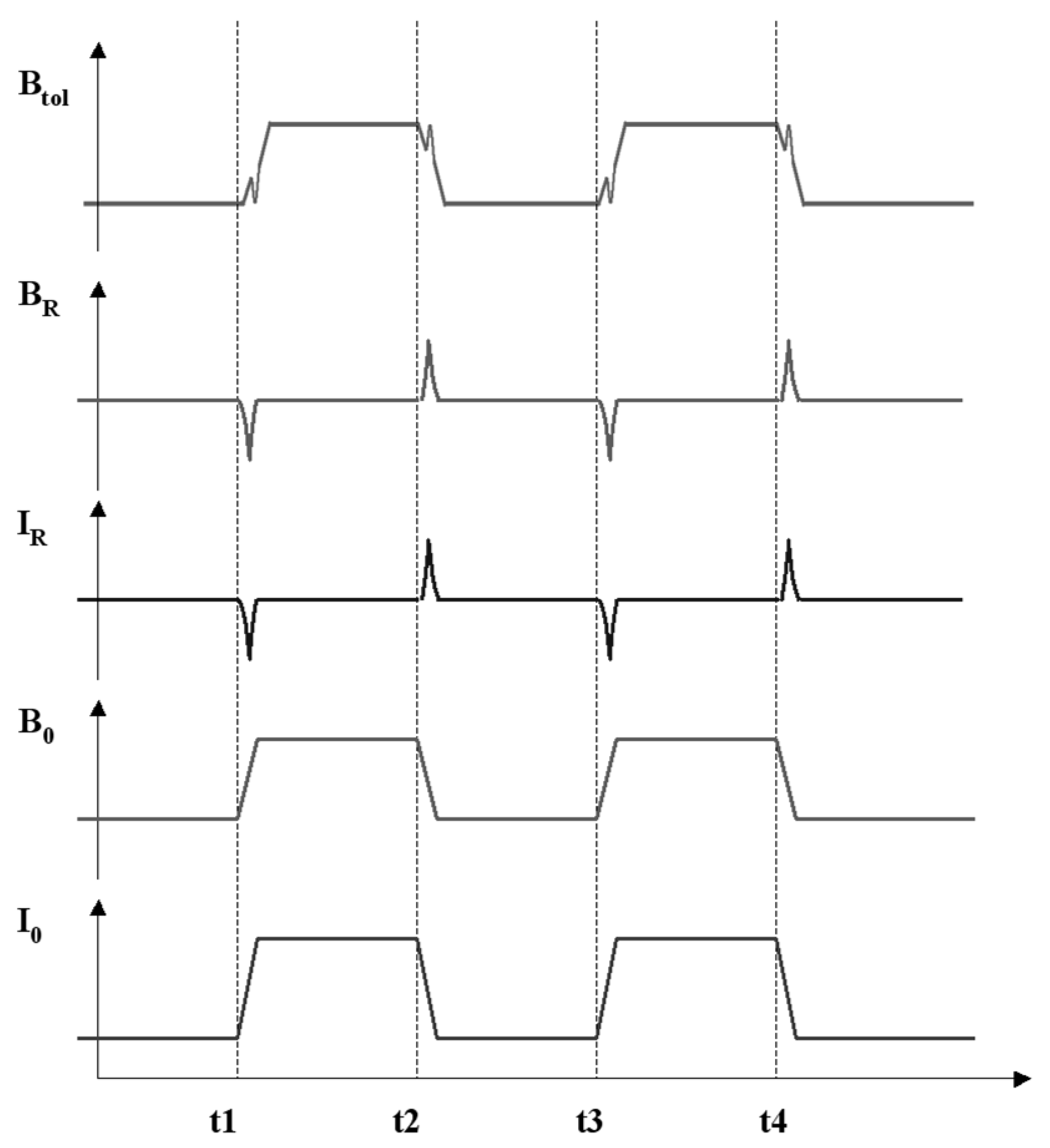
Disclaimer/Publisher’s Note: The statements, opinions and data contained in all publications are solely those of the individual author(s) and contributor(s) and not of MDPI and/or the editor(s). MDPI and/or the editor(s) disclaim responsibility for any injury to people or property resulting from any ideas, methods, instructions or products referred to in the content. |
© 2025 by the authors. Licensee MDPI, Basel, Switzerland. This article is an open access article distributed under the terms and conditions of the Creative Commons Attribution (CC BY) license (https://creativecommons.org/licenses/by/4.0/).
Share and Cite
Yan, Z.; Chen, P.; Zhang, X.; Xie, Z.; Xiu, X.; Chen, D.; Zhao, H.; Shi, Y.; Zhang, R.; Zheng, Y. Electromagnetic Nanocoils Based on InGaN Nanorings. Nanomaterials 2025, 15, 245. https://doi.org/10.3390/nano15030245
Yan Z, Chen P, Zhang X, Xie Z, Xiu X, Chen D, Zhao H, Shi Y, Zhang R, Zheng Y. Electromagnetic Nanocoils Based on InGaN Nanorings. Nanomaterials. 2025; 15(3):245. https://doi.org/10.3390/nano15030245
Chicago/Turabian StyleYan, Ziwen, Peng Chen, Xianfei Zhang, Zili Xie, Xiangqian Xiu, Dunjun Chen, Hong Zhao, Yi Shi, Rong Zhang, and Youdou Zheng. 2025. "Electromagnetic Nanocoils Based on InGaN Nanorings" Nanomaterials 15, no. 3: 245. https://doi.org/10.3390/nano15030245
APA StyleYan, Z., Chen, P., Zhang, X., Xie, Z., Xiu, X., Chen, D., Zhao, H., Shi, Y., Zhang, R., & Zheng, Y. (2025). Electromagnetic Nanocoils Based on InGaN Nanorings. Nanomaterials, 15(3), 245. https://doi.org/10.3390/nano15030245







